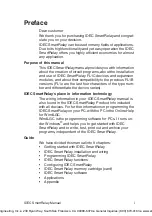
INSTALLATION STEPS
1. Cabinet Mounting
In a clean, dry area, mount the backbox using the four holes pro-
vided in the back surface of the cabinet. (See Figure 2.)
2. Module Installation
There are two methods for installing a module in the rear position
of a chassis. Method one is for installation of a rear module only,
when no module will be installed in front of it. Refer to Figure 3 for
instructions. Method two is for installation of a rear module when
another module will be installed in the chassis position in front of
it. Refer to Figures 4a and 4b for method two. All necessary screws
and standoffs are supplied with the modules.
C0237-00
FIGURE 3. INSTALLATION OF REAR MODULE ONLY, METHOD ONE
2
3
1
Step 1: Insert the bottom edge of the FIK-IM-10 module down into a rear slot
of the chassis.
Step 2: Carefully swing the upper edge of the board towards the back of the
chassis until it touches the short standoff attached to the chassis.
Step 3: Align the long standoff with the short stand off and tighten.
FIGURE 4A. INSTALLATION OF FIK-IM-10 MODULE IN A REAR CHASSIS
POSITION, METHOD TWO
1
2
3
1
FIGURE 4B. INSTALLATION OF FIK-IM-10 MODULE IN FRONT CHASSIS
POSITION
Step 1: Insert the bottom edge of the FIK-IM-10 module down into a front slot
of the chassis.
Step 2: Carefully swing the upper edge of the board towards the back of the
chassis until it touches the 11⁄4" (31.75mm) standoffs installed on the
rear module.
Step 3: Align two 4-40 screws with the two standoffs and tighten.
Step 4: Address and wire the modules according to the instructions in this manual.
WIRING
NOTE: All wiring must conform to applicable local codes, ordinances, and
regulations.
1. Install module wiring in accordance with the job drawings and appropri-
ate wiring diagrams.
2. All wiring to the FIK-IM-10 is done via terminal blocks. In order to prop-
erly make electrical connections strip approximately 1⁄4" of insulation
from the end of wire, sliding the bare end of the wire under the clamping
plate screw.
3. Set the address on the modules per the job drawing. Use the rotary code
switches to set the address of the first module between 01 and 90 (or 01
and 150 for panels that support 159 addresses).
In Class B operation, the remaining modules are automati
cally assigned to the next nine higher addresses. For example, if the base ad-
dress switch is set to 28, the next nine modules will be addressed to 29, 30, 31,
32, 33, 34, 35, 36, and 37.
The module is shipped in Class B position, remove shunt for Class A.
When operating in Class A
, alternate modules are paired together (+0/+1,
+2/+3, +4/+5, +6/+7, +8/+9), resulting in a total of five modules. For
example, if the base address switch is set to 28, then 30, 32, 34 and 36 will be
automatically assigned to the modules while 29, 31, 33, 35 and 37 are avail-
able to be used for other modules on the SLC. For Class A and B operation,
DO NOT set the lowest address above 90 (or 150 for panels that support 159
addresses), as the other modules will be assigned to nonexistent addresses.
NOTE: The FIK-IM-10 must have power cycled for shunt changes to take ef-
fect.
4. A shunt is provided to disable a maximum of two unused modules in
Class B operation and one unused module in Class A operation. Modules
are disabled from the highest address and work downward. If two mod-
ules are disabled, the lowest eight addresses will be functional, while the
highest two will be disabled. For example, in Class B operation, if the
shunt for Address Disable is placed on “two” and the base switch is set
to 28, the modules will be assigned to 28, 29, 30, 31, 32, 33, 34 and 35
while disabling the highest two positions.
5. A communications loss feature is available on some panels. Upon a com-
munication loss, due to a microprocessor failure at the control panel, the
FIK-IM-10 will send a signal to the control panel to activate the notifica-
tion device circuits upon initiating of an alarm on the FIK-IM-10. A single
shunt is used to enable (shunt on) or disable (shunt off) this feature for
all modules on the board.
NOTE: All references to power limited represent “Power Limited (Class 2)”.
NOTE: Place unused shunts on single pin to store on board for future use.
WIRING NOTES
• Power-limited circuits must employ type FPL, FPLR, or FPLP cable as
required by Article 760 of the NEC.
PROGRAMMING
The modules are programmed as devices in each system according to the pro-
gramming instructions in the appropriate FACP manual.
C0225-00
C0226-00
BACKBOX
MOUNTING
HOLES
C0235-00
FIGURE 2: TYPICAL MOUNTING HOLE LOCATIONS
Step 1: Insert the bottom of the FIK-IM-10 module down into a rear slot on
the chassis.
Step 2: Carefully swing the upper edge of the board back towards the back of
the chassis until it touches the two standoffs.
Step 3: Align two 4-40 screws with the two standoffs and tighten.
Step 4: Address and wire the modules according to the instructions in this
manual.
The steps in Figures 4a and 4b describe and illustrate module in-
stallation when the rear chassis position and the position in front of
it will be filled. Front position installation is possible only if the rear
position is filled with a module.
2
I56-6893-000
1/15/2021





















